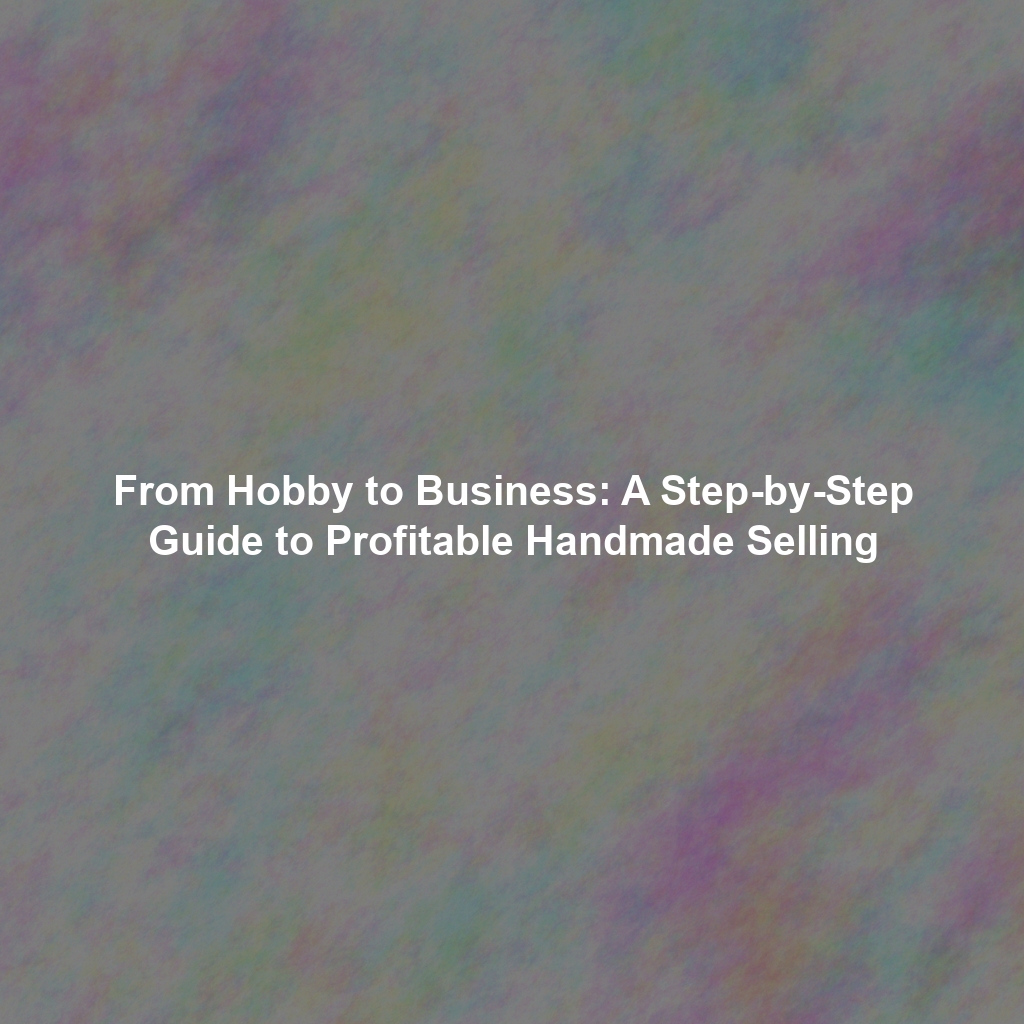From Hobby to Business: A Step-by-Step Guide to Profitable Handmade Selling
So, you love crafting? Maybe you’re a whiz with jewelry, knit the coziest scarves imaginable, or create candles that smell absolutely divine. Your friends and family are always singing your praises, and you’ve even sold a few pieces here and there. Now you’re probably wondering: can I actually turn this into a real business that makes money? The answer is a resounding YES! But going from hobbyist to business owner takes a little more than just creativity. It needs some planning, a good strategy, and a bit of business smarts.
Defining Your Target Market: Who Are You Selling To?
Before you even think about pricing or setting up an Etsy shop, you’ve gotta figure out who you’re actually selling to. Forget trying to appeal to everyone. Think about exactly *who* is most likely to buy your stuff. Ask yourself:
- Who is your ideal customer? Get specific! Age, gender, location, interests, even their income level.
- What problem does your product solve? Does it make life easier, prettier, more comfortable, or something else entirely?
- What do they care about? Are they all about eco-friendly products, do they really value handmade items, or are they hunting for something unique and personalized?
- Where do they like to shop? Etsy? Local craft fairs? Boutiques?
Instead of saying, “I sell jewelry to women,” try something like, “I sell minimalist silver jewelry to environmentally conscious women aged 25-45 who care about ethically sourced materials and love shopping on Etsy.” When you know your target market that well, you can fine-tune your products, your marketing, and even your prices to perfectly match what they want.
Calculating Your Costs Accurately: Know Your Numbers
This is where so many handmade businesses get tripped up. You absolutely can’t just guess at your prices! You *need* to know exactly how much it costs you to make each item. This includes:
- Materials: Don’t forget the little things! Thread, glue, packaging… they all add up.
- Your Labor: What’s your time worth? Seriously, pay yourself an hourly wage.
- Overhead: Rent, utilities, website fees, marketing… divvy these costs up across your products.
Let’s break it down with a hand-poured candle example:
- Wax: $2
- Fragrance Oil: $1
- Wick: $0.50
- Jar: $1.50
- Label: $0.25
- Packaging: $0.75
- Your Labor (1 hour at $20/hour): $20
- Total Cost: $26
Loads of creators forget to include the cost of their own labor. But your time is precious! Getting your costs right is key to setting prices that actually let you make a profit. Tools like TrueCraft can take a load off by automating this. It helps you track your material costs and calculate your *real* profit margins.
Setting Competitive Prices: Find Your Sweet Spot
Okay, now you know your costs. Time to set prices that are both profitable *and* tempting to your target customer. Here are a few pricing ideas to think about:
- Cost-Plus Pricing: Take your total cost and add a markup to get your selling price. Doubling or tripling your cost is pretty common. So, for our candle, a 2x markup would be $52.
- Value-Based Pricing: Base your price on how much the customer *thinks* your product is worth. If your candles are made with top-notch, all-natural stuff and give off a really luxurious vibe, you can probably charge a bit more.
- Competitive Pricing: Check out similar products on Etsy and other online shops to see what they’re going for. Then, tweak your prices, keeping in mind what makes your stuff special.
Don’t be afraid to play around with different pricing strategies until you find the one that clicks. Think about offering discounts or promotions to get new customers in the door or thank your regulars.
Scaling Your Handmade Business: Grow Without Losing Your Soul
Once you’ve got a business that’s actually making money, you might start thinking about scaling it up. This doesn’t mean you need to become some huge corporation. It just means figuring out how to make more stuff and bring in more money without losing the quality and craftsmanship that makes your products so awesome.
Here are some things to try when scaling your handmade business:
- Make Your Production Process Smoother: Look for ways to work faster without cutting corners on quality. Can you make certain parts in batches? Can you set up your workspace in a more efficient way?
- Outsource the Boring Stuff: Think about hiring a virtual assistant to handle things like paperwork, social media, or customer service.
- Upgrade Your Equipment: Better tools can help you make more products faster and cut down on labor costs.
- Sell in More Places: Think about selling on Etsy, Shopify, local craft fairs… the more, the merrier!
- Automate What You Can: Use tools to handle things like accounting and inventory. TrueCraft connects with Etsy and Shopify to give you up-to-the-minute info on your sales, expenses, and profits, so you can make smart choices for your business.
Scaling takes careful planning. Start small, track what happens, and be ready to change things up as your business grows. The goal is to build a business that’s sustainable and fulfilling, where you can share your passion with the world and actually make a living doing it!
Turning your handmade hobby into a profitable business is totally doable if you’ve got the right mindset, a solid plan, and the right tools. By knowing who you’re selling to, figuring out your costs, setting good prices, and scaling strategically, you can create a thriving business that brings you both financial success and a whole lot of happiness. Good luck, and happy crafting!


